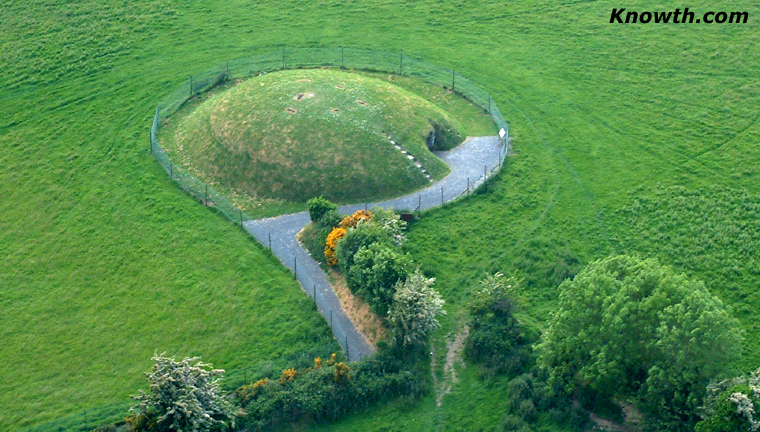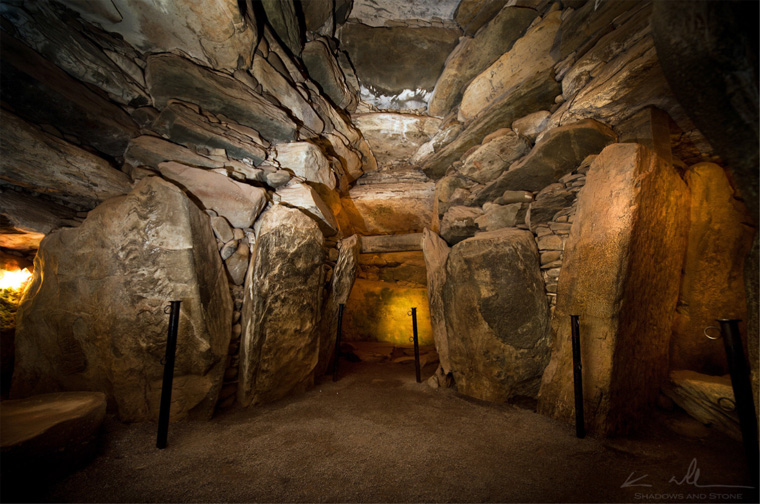
We Have Never Been Material.
Andrew Cochrane 2007 - Page 6CLOSE ENCOUNTERS OR DIALECTICS AT STANDSTILL? (Continued)
The placement of cremated remains on the passage tomb floors would have created textured surfaces that would have altered visual interactions and perceptions. The recurring material artefacts, such as stone axeheads, decorated pottery sherds and chalk balls of varying colours, all exhibit enhanced visual, auditory, olfactory, and tactile qualities, with form and content coalescing to augment performances that stimulated sensory responses. The combination of these objects within a decorated structure may reflect material expressions of believed ideas regarding how people should live, die, transform, and the world(s) in general.Following Latour (1993, 139), we may broaden these assemblages of objects to the concept of the assemblages of societies; thus creating a constant and sometimes interrupted transformation and mediation of appearance, participation and being. Yet, material objects are not free in the modern sense of liberation, but are rather bound together with people in relational ties. Indeed, it is the things in life that make humans and the humans in life that make things, blurring human:non-human distinctions (Latour 2000, 20). Within such a framework, objects do not engender themselves through representation, but instead through processes of metamorphosis and performance. Passage tombs are therefore not just containers of objects; rather they actively merge containment with content.
What we may be witnessing in passage tombs therefore is the distillation and manipulation of objects and persons (which again may not be separate categories) within a web of relationships. For example, following some transactions by the Merina of Madagascar (Bloch 1998, 79), we might suggest that relationships between the 'dry' mixtures (e.g. cremations) and 'wet' mutable substances (e.g. people or pottery?) may have been at play, endlessly being altered by the moment and the images on the structural stones. For the Merina, contact is made during life with the dead in tombs, establishing never-ending cycles and mixtures whereby the living increasingly become the dead and the dead become the living, thus blurring these oppositional stances.
CONCLUSIONS
Everything which offends against duality, which is the fundamental rule, everything which aims to be integral, leads to disintegration through the violent resurgence of duality. Jean BaudrillardWhat are the consequences of attempting to understand some past events via the removal of dialectical approaches and dualities? Baudrillard might answer that the abolition of distance between opposite poles leads to the discharge of violent tension as a result of the intimate blending of parts in the world (2005, 75-77; see also González-Ruibal 2006). After considering how things may intimately operate, I feel, however, that tactile interaction is not mere reductive immersion with mixtures of elements, none of which constitute 'pure' forms; rather it is an effective means of negotiating within environments. These fluid entanglements or mixing of mixes are enhanced when one appreciates that the objects in passage tombs were not all deposited at the same time. This suggests multiple temporalities or 'extra-temporality' (Virilio 2000, 85), with some being plural, contradictory, scrambled and palimpsestic. By looking in detail at the assemblages and blending of essences in some Irish passage tombs I have attempted to tease out some of the threads that help bind these amalgamations.
ACKNOWLEDGEMENTS
I would like to thank Alasdair Whittle and Doug Bailey for reading and commenting on earlier versions of this paper - the mistakes and misunderstandings are my responsibility alone. I would also like to thank Muiris O'Sullivan and Wordwell Publishers for kindly giving permission to use several of their images. Chris Witmore was very kind and supportive by allowing me access to his unpublished work and ideas. Ken Williams has generously allowed me to use images from his recent 'Shadows and Stones' exhibition. Respect to Ian Russell for many late night discussions! Kate Waddington deserves much thanks for reading many sections of this piece. I would also like to thank Julian Thomas and Vitor Oliveria Jorge for organising the Tag 2006 session.References
Previous Page (5)
Boyne Valley Private Day Tour
 Immerse yourself in the rich heritage and culture of the Boyne Valley with our full-day private tours.
Visit Newgrange World Heritage site, explore the Hill of Slane, where Saint Patrick famously lit the Paschal fire.
Discover the Hill of Tara, the ancient seat of power for the High Kings of Ireland.
Book Now
Immerse yourself in the rich heritage and culture of the Boyne Valley with our full-day private tours.
Visit Newgrange World Heritage site, explore the Hill of Slane, where Saint Patrick famously lit the Paschal fire.
Discover the Hill of Tara, the ancient seat of power for the High Kings of Ireland.
Book Now
Home
| Newgrange
| Knowth
| Dowth
| Hill of Tara
| Fourknocks
| Loughcrew
| More Places
| Labyrinths
| Local Info
| Art Works
| Articles
| Images
| Books
| Links
| Boyne Valley Tours
| Contact

